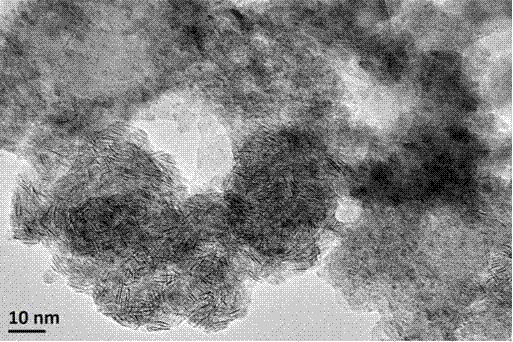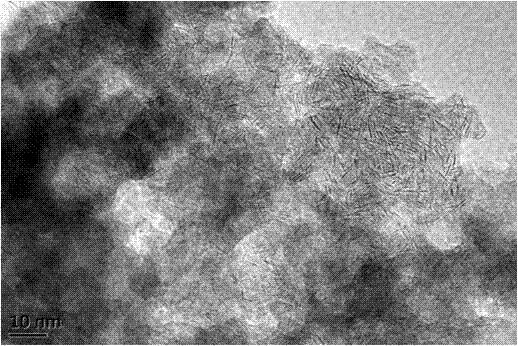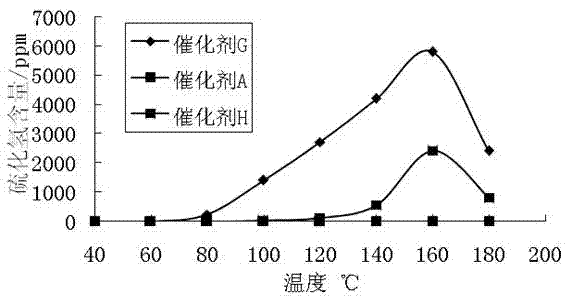Hydrotreating catalyst intermediate, hydrotreating catalyst, and preparation methods of hydrotreating catalyst intermediate and hydrotreating catalyst
A hydrogenation treatment and catalyst technology, which is applied in the direction of physical/chemical process catalysts, chemical instruments and methods, organic chemistry, etc., can solve the problem that the active metal component cannot fully play its role, the hydrogenation catalyst cannot be completely vulcanized, the active metal group Insufficient vulcanization and other problems can be solved to shorten the start-up time, solve the problems of airtightness and heat release, and facilitate storage and transportation
- Summary
- Abstract
- Description
- Claims
- Application Information
AI Technical Summary
Problems solved by technology
Method used
Image
Examples
Embodiment 1
[0058] Example 1 Preparation of Hydrotreating Catalyst A
[0059] Weigh 40.6g of ammonium molybdate, 21.7g of nickel nitrate, and 50mL of ammonia water, and mix them with deionized water to 100mL to obtain solution I. Dissolve 41 g of 2,4,6-trimercapto-s-triazine triammonium salt in 50 mL of water to obtain solution II. Weigh 84g of macroporous pseudo-boehmite (73wt% on a dry basis) and 24mL of silica gel (containing 30wt% of silicon dioxide) into 1L of water, stir vigorously for 20min, add solutions I and II side-by-side, and then After stirring for 30 min, wash and filter with suction. The filter cake obtained by suction filtration was heat-treated at a low temperature of 80° C. for 3 hours. After the filter cake is pulverized, add 3 g of scallop powder and mix evenly, then mix 42 g of small-pore alumina with 3 g of citric acid, 10 mL of nitric acid (concentration: 30 wt%), and 120 mL of deionized water to make a slurry as a binder. After rolling for 20 min, the Extruded ...
Embodiment 2
[0060] Example 2 Preparation of Hydrotreating Catalyst B
[0061] Take 33.5g of molybdenum oxide, 9.2g of basic nickel carbonate, 2mL of phosphoric acid, and 60mL of deionized water, mix them uniformly and boil for 1 hour to obtain solution I. Weigh 58 g of 2,4-dimercapto-s-triazine diammonium salt and dissolve it in 100 mL of acetone solution to obtain solution II. Weigh macroporous pseudo-boehmite (dry basis is 73wt%) 72g, zirconium oxychloride 12g and water-soluble silicone oil 20g, put into 1L water then, after strong stirring for 20min, solution 1 is dripped into the slurry and stirred for 10min, Then the solution II was dripped into the slurry, stirred vigorously during the dripping process, then stirred for 30 minutes, washed, and suction filtered. The filter cake obtained by suction filtration was heat-treated at a low temperature of 80° C. for 3 hours. After the filter cake is pulverized, add 3 g of scallop powder and mix evenly, then mix 56 g of small-pore alumina ...
Embodiment 3
[0062] Example 3 Preparation of Hydrotreating Catalyst C
[0063] Weigh 40.6g of ammonium molybdate, 21.7g of nickel nitrate, and 50mL of ammonia water, and mix them with deionized water to 100mL to obtain solution I. 102 g of 2,4,6-trimercapto-s-triazine monoammonium salt was dissolved in 50 mL of water to obtain solution II. The other steps were the same as in Example 1 to obtain hydrogenation catalyst C. The main physical properties are shown in Table 1.
PUM
| Property | Measurement | Unit |
|---|---|---|
| specific surface area | aaaaa | aaaaa |
| diameter | aaaaa | aaaaa |
| specific surface area | aaaaa | aaaaa |
Abstract
Description
Claims
Application Information
 Login to View More
Login to View More - R&D
- Intellectual Property
- Life Sciences
- Materials
- Tech Scout
- Unparalleled Data Quality
- Higher Quality Content
- 60% Fewer Hallucinations
Browse by: Latest US Patents, China's latest patents, Technical Efficacy Thesaurus, Application Domain, Technology Topic, Popular Technical Reports.
© 2025 PatSnap. All rights reserved.Legal|Privacy policy|Modern Slavery Act Transparency Statement|Sitemap|About US| Contact US: help@patsnap.com



